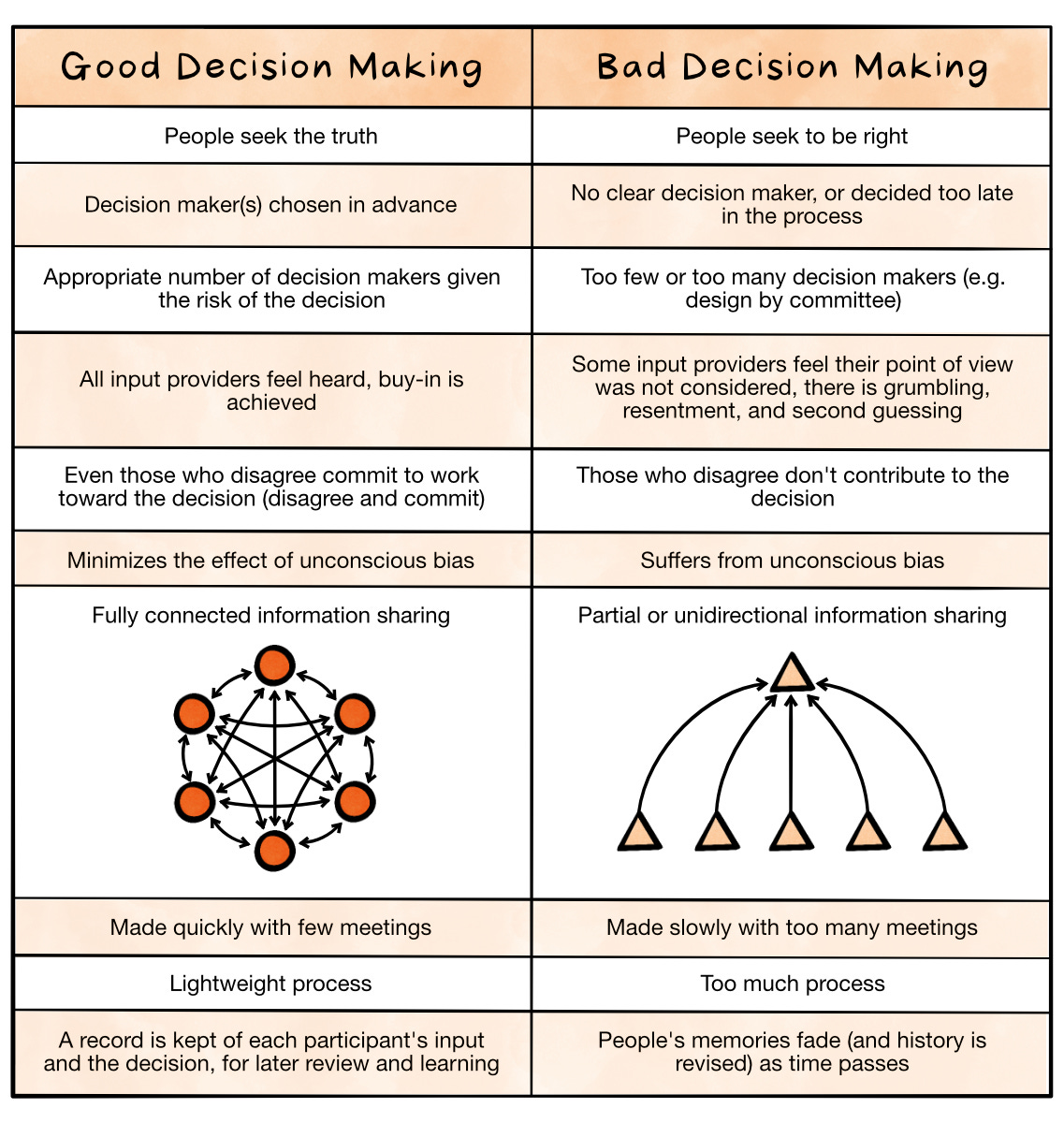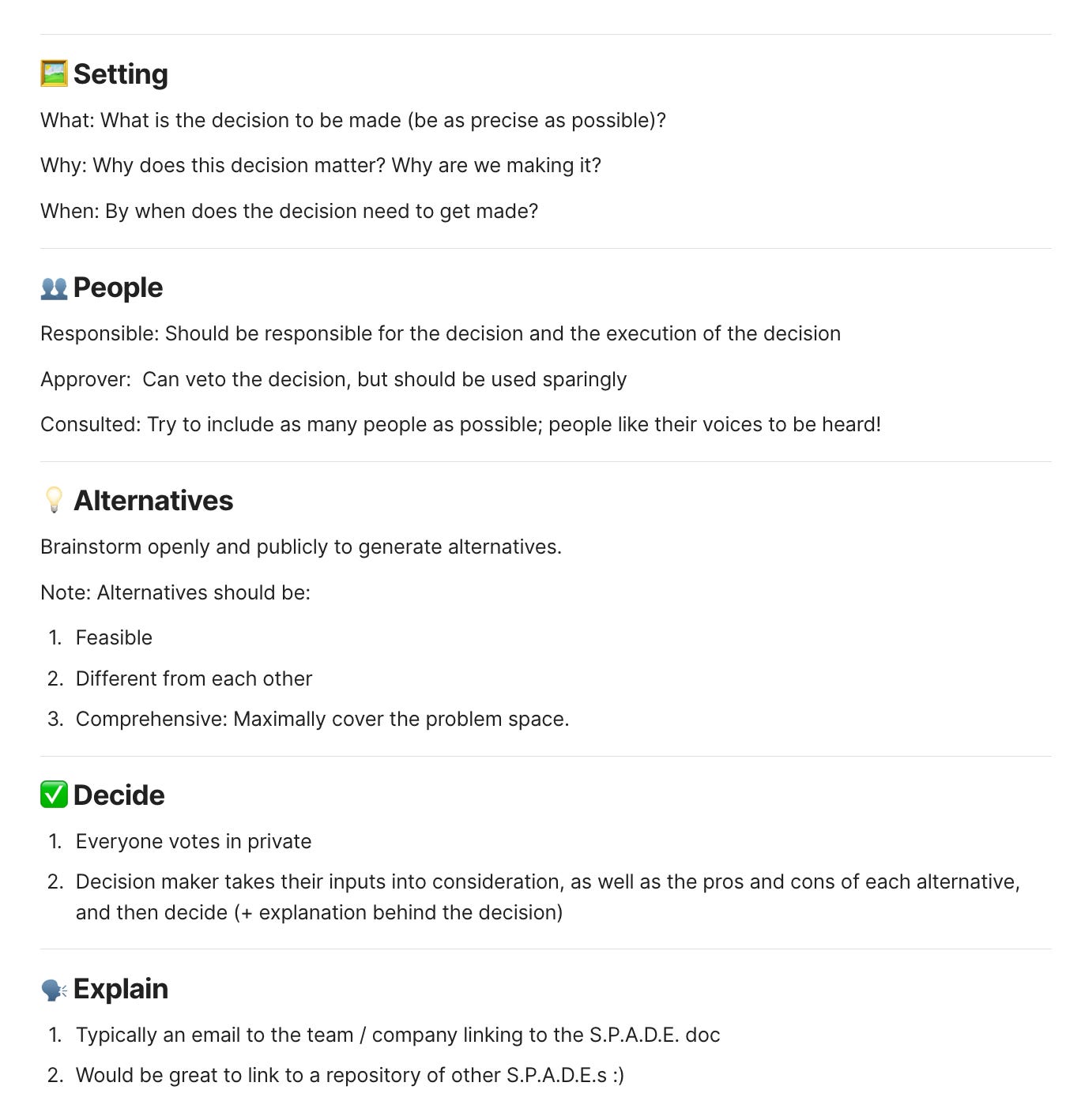
Highlights §
- Companies live and die by the quality of their decisions. One better decision can change the trajectory of your business. Yet important decisions often get mired in head-banging meetings, debates, and consensus seeking. And as your company grows, you’ll inevitably run into decision-making challenges. (View Highlight)
- Below I’ll share several battle-tested decision-making frameworks that are designed to help you make better decisions more quickly and with less drama. Although no framework will make hard decisions easy, having a framework can significantly cut down on the head banging. (View Highlight)
- Prioritize trust: If your team is asking you to use a decision-making framework on many decisions, it could be a sign they don’t super-trust your judgment. Before running every decision through a framework, dig into this potential issue. You’re better off long-term getting things done through influence and trust, versus jumping to a framework. That being said, as your company scales and the number of stakeholders grows, even with high trust there’s often a need for a structured process to make sure everyone’s voice is heard. (View Highlight)
- Save frameworks for big (one-way-door) decisions: As Gokul Rajaram put it, “[A decision-making] framework isn’t meant for every situation. It’s meant for hard decisions. Things that would have real consequences for a company or group. Not all decisions are important. At Square, we used to jokingly call this the ‘kombucha scale,’ which captures two variables: importance and urgency. If the choice is as simple as selecting a flavor of kombucha, everyone can save the time and effort spent on a thorough decision-making process.” (View Highlight)
 (View Highlight)
(View Highlight) (View Highlight)
(View Highlight)- Keep in mind as you work on your decision-making process, as Jeff Bezos said in his conversation with Lex Fridman, that “humans are social animals. Not truth-seeking animals. Important truths can be uncomfortable and make people defensive. Any high-functioning organization has to have mechanisms and a culture that supports truth-telling. You have to talk about that and how it takes energy.” (View Highlight)
- This popular framework, by Gokul Rajaram, finds a nice balance between structure and simplicity. It forces you to clarify the problem, identify roles, lay out timelines, and explore all possible alternatives, without making the process too rigid. Most importantly, it helps you avoid consensus thinking while also making sure that the person who makes the final decision is also accountable for the end result. (View Highlight)
- “A lot of forward-thinking companies practice consensus. Google is famous for it. But consensus is impractical and ineffective for one clear reason: consensus means no ownership. What is important isn’t that everyone agrees, it’s that everyone is listened to. And then the right person makes a decision, communicates it clearly, and rallies everyone around it. (View Highlight)
- It’s not the decisions themselves employees are frustrated with, it’s the lack of transparency around how decisions are made. And employees crave transparency (View Highlight)
- A couple Square colleagues and I decided to come up with a new decision-making framework, an alternative to consensus built on accountability and clarity, where the person responsible for executing the decision would be the one who decides.” (View Highlight)
- Here’s a template, instructions, and an example. This framework is best used when making a major decision, at the company or strategy level.
 (View Highlight)
(View Highlight)
- This framework is very similar to S.P.A.D.E. but is more compact (everything fits inside a single Google Sheet) and includes some unique attributes, like allowing multiple deciders and giving the decision an expiration date. Since it’s so simple and compact, it can flex across most decisions. (View Highlight)
- I’ve seen it run from start to finish in under 15 minutes, live during a meeting, but it can also be used over multiple weeks for bigger decisions.
The vast majority of decisions in a company are low-risk and should be made unilaterally by the owner of that area (e.g. should we move the standup meeting from Mon. to Tues. this week?). (View Highlight)
- A decision-making framework is only needed when there is lack of clarity about a decision that is higher-risk. Higher risk can mean that the decision has long-term implications or that it can be costly to unwind if the wrong decision is made.” (View Highlight)
- Here’s a template, and instructions for how to use it. This framework is best used when you need a framework that you can apply to both big and small decisions. (View Highlight)
- This is a two-part meta-framework developed by Shishir Mehrotra (CEO of Coda) that dozens of companies have integrated into their daily workflows. It’s especially good at making sure everyone’s voice is heard, and flexing to all kinds of use-cases. (View Highlight)
- “I did some quick math, and in the past year I’ve used Dory/Pulse over a thousand times. It’s a simple yet impactful ritual for supercharging decisions by equalizing voices and removing groupthink in meetings. (View Highlight)
- I decided to catalog the many different ways I’ve seen teams use Dory/Pulse. As I polled teams, this list quickly grew from a handful of variations to 14. You can see the full set in my post 14 ways to Dory/Pulse. (View Highlight)
- Teams scaling their company all-hands were drawn to techniques like Unbiased Dory and Anonymous Dory (View Highlight)
- Teams focused on product/design proposal reviews invented Sentence Starter Dory and Pick an Option Pulse (View Highlight)
- Teams struggling with hard prioritization choices landed on $100 Voting Pulse and Ranked Choice Pulse (View Highlight)
- Teams challenged with moving beyond ‘majority rules’ consensus-driven decision-making landed on Role-centric Pulse and Conviction, Disagree, and Commit Pulse (View Highlight)
- Here are templates and instructions. This framework is best used when you are looking to make decisions in real time (i.e. during a meeting). (View Highlight)

 (View Highlight)
(View Highlight) (View Highlight)
(View Highlight) (View Highlight)
(View Highlight)